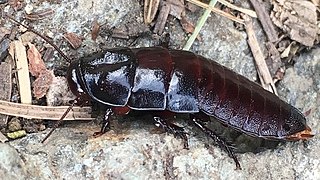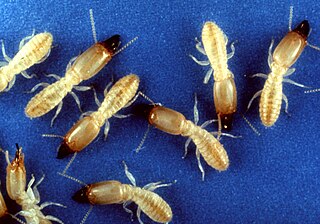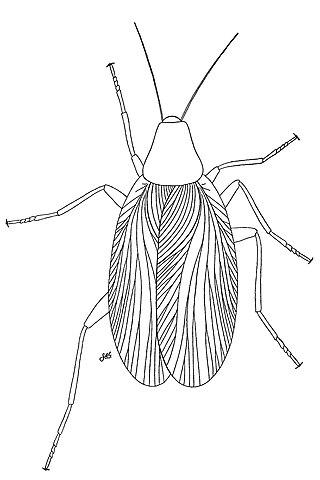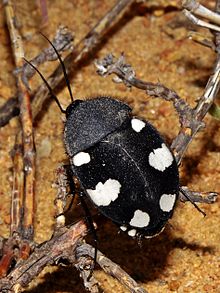
Termites are a group of detritophagous eusocial insects which consume a wide variety of decaying plant material, generally in the form of wood, leaf litter, and soil humus. They are distinguished by their moniliform antennae and the soft-bodied and often unpigmented worker caste for which they have been commonly termed "white ants"; however, they are not ants, to which they are distantly related. About 2,972 extant species are currently described, 2,105 of which are members of the family Termitidae.

Trophallaxis is the transfer of food or other fluids among members of a community through mouth-to-mouth (stomodeal) or anus-to-mouth (proctodeal) feeding. Along with nutrients, trophallaxis can involve the transfer of molecules such as pheromones, organisms such as symbionts, and information to serve as a form of communication. Trophallaxis is used by some birds, gray wolves, vampire bats, and is most highly developed in eusocial insects such as ants, wasps, bees, and termites.

Dictyoptera is an insect superorder that includes two extant orders of polyneopterous insects: the order Blattodea and the order Mantodea (mantises). All modern Dictyoptera have short ovipositors and typically lay oothecae. The oldest fossils of Dictyoptera from the Late Carboniferous, referred to as "roachoids" have long ovipositors and did not lay oothecae. The oldest modern oothecae-laying dictyopterans date to the Late Triassic.

Cryptocercus is a genus of Dictyoptera and the sole member of its own family Cryptocercidae. Species are known as wood roaches or brown-hooded cockroaches. These roaches are subsocial, their young requiring considerable parental interaction. They also share wood-digesting gut bacteria types with wood-eating termites, and are therefore seen as evidence of a close genetic relationship, that termites are essentially evolved from social cockroaches.

Cockroaches are insects belonging to the order Blattodea (Blattaria). About 30 cockroach species out of 4,600 are associated with human habitats. Some species are well-known as pests.

The giant burrowing cockroach is also known as the rhinoceros cockroach, and Queensland giant cockroach. These cockroaches are native to Australia and mostly found in tropical and subtropical parts of Queensland. They are the world's heaviest species of cockroach and can weigh up to 30-35 grams and measure up to 7.5-8 cm (3.1 in) in length. It is a member of the family Blaberidae, which contains hundreds of species. It is part of the blaberid subfamily Geoscapheinae. It is prominent in the wild and can also be sold and kept as a pet.

Reticulitermes flavipes, the eastern subterranean termite, is the most common termite found in North America. These termites are the most economically important wood destroying insects in the United States and are classified as pests. They feed on cellulose material such as the structural wood in buildings, wooden fixtures, paper, books, and cotton. A mature colony can range from 20,000 workers to as high as 5 million workers and the primary queen of the colony lays 5,000 to 10,000 eggs per year to add to this total.

The gyne is the primary reproductive female caste of social insects. Gynes are those destined to become queens, whereas female workers are typically barren and cannot become queens. Having a queen is what makes a "queenright" hive, nest, or colony of eusocial insects. A colony with multiple queens is said to be a polygyne form, whereas one with only one is a monogyne form.

"Roachoids", also known as "Roachids", "Blattoids" or Eoblattodea, are members of the stem group of Dictyoptera. They generally resemble cockroaches, but most members, unlike modern dictyopterans, have generally long external ovipositors, and are thought not to have laid ootheca like modern dictyopterans.
Task allocation and partitioning is the way that tasks are chosen, assigned, subdivided, and coordinated within a colony of social insects. Task allocation and partitioning gives rise to the division of labor often observed in social insect colonies, whereby individuals specialize on different tasks within the colony. Communication is closely related to the ability to allocate tasks among individuals within a group. This entry focuses exclusively on social insects. For information on human task allocation and partitioning, see division of labour, task analysis, and workflow.

Eusociality, the highest level of organization of sociality, is defined by the following characteristics: cooperative brood care, overlapping generations within a colony of adults, and a division of labor into reproductive and non-reproductive groups. The division of labor creates specialized behavioral groups within an animal society which are sometimes referred to as 'castes'. Eusociality is distinguished from all other social systems because individuals of at least one caste usually lose the ability to perform at least one behavior characteristic of individuals in another caste. Eusocial colonies can be viewed as superorganisms.

Therea petiveriana, variously called the desert cockroach, seven-spotted cockroach, or Indian domino cockroach, is a species of crepuscular cockroach found in southern India. They are members of a basal group within the cockroaches. This somewhat roundish and contrastingly marked cockroach is mainly found on the ground in scrub forest habitats where they may burrow under leaf litter or loose soil during the heat of the day.

Nasutitermes corniger is a species of arboreal termite that is endemic to the neotropics. It is very closely related to Nasutitermes ephratae. The species has been studied relatively intensively, particularly on Barro Colorado Island, Panama. These studies and others have shown that the termite interacts with many different organisms including a bat that roosts in its nest and various species of ants that cohabit with the termite.
Blattabacterium is a genus of obligate mutualistic endosymbiont bacteria that are believed to inhabit all species of cockroach studied to date, with the exception of the genus Nocticola. The genus' presence in the termite Mastotermes darwiniensis led to speculation, later confirmed, that termites and cockroaches are evolutionarily linked.

Eusociality evolved repeatedly in different orders of animals, notably termites and the Hymenoptera. This 'true sociality' in animals, in which sterile individuals work to further the reproductive success of others, is found in termites, ambrosia beetles, gall-dwelling aphids, thrips, marine sponge-dwelling shrimp, naked mole-rats, and many genera in the insect order Hymenoptera. The fact that eusociality has evolved so often in the Hymenoptera, but remains rare throughout the rest of the animal kingdom, has made its evolution a topic of debate among evolutionary biologists. Eusocial organisms at first appear to behave in stark contrast with simple interpretations of Darwinian evolution: passing on one's genes to the next generation, or fitness, is a central idea in evolutionary biology.

Incisitermes minor is a species of termite in the family Kalotermitidae known commonly as the western drywood termite. It is native to western North America, including the western United States and northern Mexico. It has been found in many other parts of the United States, all the way to the East Coast. It has been reported from Toronto. It has been introduced to Hawaii. It has been noted in China and it is not uncommon in Japan. This is an economically important pest of wooden structures, including houses. In California and Arizona alone its economic impact is estimated to be about $250 million per year.

Zootermopsis nevadensis, the Nevada termite, is a eusocial species of termite (Isoptera) in the family Archotermopsidae, a group known as the dampwood termites. It is a hemimetabolous organism.
Metapolybia cingulata is a species of social paper wasp known for having queens who exhibit usurpation behaviors and also for having flexible behavior groups. It is difficult to tell what a specific wasp's role is just upon observation. Therefore, dissections are usually performed in order to determine the sex, and thus the wasp's role in the colony. The regulating behavior, or nest building, most closely resembles that of primitive Polistes models where a queen solicits liquid from a fellow worker and then takes pulp to initiate building a cell without leaving the nest. In nest building, the amount of water present in the nest as well as the activity of the builders of the nests determines the activity of the colony.

Social immunity is any antiparasite defence mounted for the benefit of individuals other than the actor. For parasites, the frequent contact, high population density and low genetic variability makes social groups of organisms a promising target for infection: this has driven the evolution of collective and cooperative anti-parasite mechanisms that both prevent the establishment of and reduce the damage of diseases among group members. Social immune mechanisms range from the prophylactic, such as burying beetles smearing their carcasses with antimicrobials or termites fumigating their nests with naphthalene, to the active defenses seen in the imprisoning of parasitic beetles by honeybees or by the miniature 'hitchhiking' leafcutter ants which travel on larger worker's leaves to fight off parasitoid flies. Whilst many specific social immune mechanisms had been studied in relative isolation, it was not until Sylvia Cremer et al.'s 2007 paper "Social Immunity" that the topic was seriously considered. Empirical and theoretical work in social immunity continues to reveal not only new mechanisms of protection but also implications for understanding of the evolution of group living and polyandry.

Cryptocercus punctulatus, known generally as brown-hooded cockroach, is a species of cockroach in the family Cryptocercidae. Other common names include the woodroach, wingless wood roach, and eastern wood-eating cockroach. It is found in North America.





















